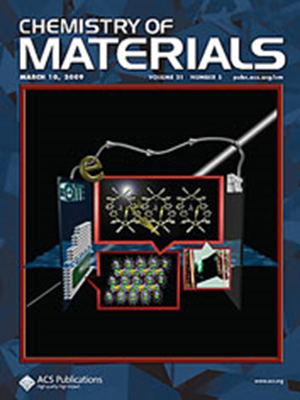Gold Nanoparticle Ligand Structure Investigated with Solution NMR: Effects of Ligand Length on Headgroup Dynamics and Ion Penetration
IF 7.2
2区 材料科学
Q2 CHEMISTRY, PHYSICAL
引用次数: 0
Abstract
Herein, we report the synthesis of a library of 16 gold nanoparticle (AuNP) types (2, 4, 9, and 12 nm in diameter and appended with mercapto-(X-alkyl)-N,N,N-trimethylammonium bromide (MxTAB) ligands (X = 11, 16, 18, or 20)) and detailed characterization of their ligand shell with solution 1H NMR in deuterium oxide. The trimethylammonium headgroup is bulky, and the unique chemical shifts of its protons allow for systematic studies of ligand density and dynamics as a function of both nanoparticle size and ligand length for fully saturated surfaces. Chemical shift analysis of the solvent-exposed headgroup protons supports the notion that ligand headgroups pack closer together as the AuNP diameter increases for all ligands. Quantitative analysis shows that ligand density for the shorter ligands (MUTAB (X = 11) and MTAB (X = 16)) is dependent on nanoparticle size, ranging from ∼10 to ∼2 molecules/nm2 as the nanoparticle size increases, while ligand density is independent of size (∼2 molecules/nm2) for longer ligands (MOTAB (X = 18) and MITAB (X = 20)). T2 relaxation analysis shows less headgroup motion and therefore more ordering as both the NP diameter and the chain length increase. Gold etching experiments with potassium cyanide were performed to determine the ability of ions to penetrate the ligand layers; core protection and headgroup motion, as judged by T2, were negatively correlated for the two shorter ligands but not correlated with the two longer ligands. Molecular dynamics simulations indicated that the longer ligands have a stronger tendency to form ligand islands on curved surfaces due to increased van der Waals interactions between the alkane portions of ligands, suggesting that the presence of patchy ligand islands displays hydrophobic character that prevents the cyanide ion from penetrating the AuNP cores. The relationship between ligand length and nanoparticle diameter/curvature leads to rudimentary predictions of ligand dynamics.

用溶液核磁共振研究金纳米颗粒配体结构:配体长度对头基动力学和离子穿透的影响
在此,我们合成了16种金纳米颗粒(AuNP)类型(直径2,4,9和12 nm,并附加有巯基-(X-烷基)-N,N,N-三甲基溴化铵(MxTAB)配体(X = 11, 16, 18或20))的文库,并在氧化氘溶液中用1H NMR详细表征了它们的配体壳。三甲基铵头基体积庞大,其质子的独特化学位移允许系统地研究配体密度和动力学,作为纳米颗粒大小和完全饱和表面配体长度的函数。暴露于溶剂中的头基质子的化学位移分析支持这样一种观点,即随着所有配体的AuNP直径的增加,配体的头基聚集得更紧密。定量分析表明,较短配体(MUTAB (X = 11)和MTAB (X = 16))的配体密度取决于纳米颗粒大小,随着纳米颗粒大小的增加,其范围从~ 10到~ 2分子/nm2,而较长的配体(MOTAB (X = 18)和MITAB (X = 20))的配体密度与大小(~ 2分子/nm2)无关。T2弛豫分析表明,随着NP直径和链长的增加,头群运动减少,因此有序性增强。用氰化钾对金进行蚀刻实验,以确定离子穿透配体层的能力;通过T2判断,两种较短配体的核心保护和头基运动呈负相关,而与两种较长的配体不相关。分子动力学模拟表明,由于配体的烷烃部分之间的范德华相互作用增加,较长的配体在曲面上形成配体岛的倾向更强,这表明斑块配体岛的存在表现出疏水特性,阻止氰化物离子穿透AuNP核。配体长度和纳米颗粒直径/曲率之间的关系导致配体动力学的基本预测。
本文章由计算机程序翻译,如有差异,请以英文原文为准。
求助全文
约1分钟内获得全文
求助全文
来源期刊

Chemistry of Materials
工程技术-材料科学:综合
CiteScore
14.10
自引率
5.80%
发文量
929
审稿时长
1.5 months
期刊介绍:
The journal Chemistry of Materials focuses on publishing original research at the intersection of materials science and chemistry. The studies published in the journal involve chemistry as a prominent component and explore topics such as the design, synthesis, characterization, processing, understanding, and application of functional or potentially functional materials. The journal covers various areas of interest, including inorganic and organic solid-state chemistry, nanomaterials, biomaterials, thin films and polymers, and composite/hybrid materials. The journal particularly seeks papers that highlight the creation or development of innovative materials with novel optical, electrical, magnetic, catalytic, or mechanical properties. It is essential that manuscripts on these topics have a primary focus on the chemistry of materials and represent a significant advancement compared to prior research. Before external reviews are sought, submitted manuscripts undergo a review process by a minimum of two editors to ensure their appropriateness for the journal and the presence of sufficient evidence of a significant advance that will be of broad interest to the materials chemistry community.
 求助内容:
求助内容: 应助结果提醒方式:
应助结果提醒方式:


